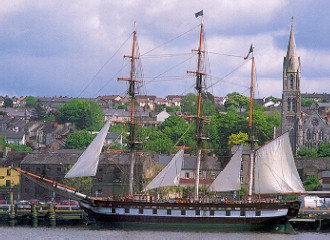 |
 |

The Dunbrody
[Saturday - 11/16/02] She rises from the water like a ghostly reminder of the year 1849, a terrible year for the people of Ireland. The ship moored near the tourist information center in the town of New Ross is a new reminder of the past — a past that for thousands of Irish emigrants was one of intense suffering, personal hardship and choices that ripped families apart and left a trail of bodies all across Ireland.
Construction for the Dunbrody began in November 1996, and she was launched in a grand ceremony on February 11, 2001. The new ship was built with plans from the original. That ship was built in six hurried months in 1845 for the Graves family of New Ross.
The original Dunbrody was put into immediate service in the lucrative trade between Ireland and Canada, as well as one trip to Peru to pick up a load of guano. It was not a glamorous trade, but these were decidedly unglamorous times. The potato famine was raging in Ireland and hundreds of thousands of poor tenant farmers with their families were racing against hunger and poverty for a new life across the Atlantic.
They packed into these small ships by the hundreds. The Dunbrody is classified as a Three Masted Barque, a small ship which carried between 176 and 310 steerage and first class passengers, plus crew in unbelievably crowded conditions below deck. Built as a timber hauling ship, it had spartan facilities and no built in comforts.
For those few who had the 25 pounds per person, a huge sum in 1849, a first-class cabin meant relative privacy — the privilege of eating the same meals as the captain and officers ate and even the use of private toilets. The rest of the cargo — and that's what these immigrants were, cargo — were piled two families high on wooden bunks. The bunks not only had to accommodate all the members of a family, but their belongings as well.
On a typical voyage lasting some 50 or so days to Quebec from New Ross, it was not unusual to lose 40 percent of the passengers to sickness. Close quarters and unsanitary conditions, combined with people who were already weakened by famine, meant many unceremonious burials at sea.
The smell below decks would have been overpowering. Not only did passengers have to put up with the smells of disease, sickness and unwashed bodies, but also the smell from the cargo brought over on the voyage to Ireland. For the Dunbrody, this was usually guano. This grayish material, bird droppings, was used as fertilizer in both Ireland and Scotland.
Those who paid their three pounds for steerage passage aboard the original Dunbrody hoped for the best possible conditions. A kind captain made all the difference between utter misery and near starvation. One captain of a ship similar in size to the Dunbrody packed his steerage passengers into tiny quarters, so that he could fill the rest of the steerage compartment with rum to sell once he landed in Australia.
Aboard the ship, life quickly settled into a stupefying existence revolving around waiting in line to use one of two topside cooking fires. (Imagine up to 300 people trying to cook on a pitching, rolling deck.) Inclement weather meant no fires, and a huddled, terrifying time in near total darkness in the steerage compartment. Bread and if they were lucky, a drop or two of water was all that could be provided for sustenance in stormy weather.
A total of six toilets were shared by up to 300 passengers. The crew was kept apart from the steerage passengers by solid walls below decks. Strict instructions were given to avoid these passengers above deck as well, because of the fear that their diseases would become the crew's diseases. The loss of even one man from the crew would mean extreme danger for the safety and handling of the tiny ship.
The original Dunbrody was in service from 1845, making two round trips for each of the 24 years she worked for the Graves family. In 1870, she was sold to Cardiff and then to Bremen in 1874. A year later, she was stranded and lost off Belle Isle in Labrador.
|
Last modified on Wednesday, November 26, 2008 URL: http://www.housecorvus.org/dun.htm Copyright © 2002-09 House Corvus. All rights reserved. Design and hosting by Bran Trefonnen. | |